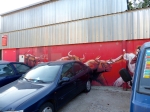We had breakfast at Cafe Iruña, which was Hemingway’s favorite hang out. There is a full size sculpture of him at a special bar. Just as every old house in America likes to claim “Washington slept here,” every bar in Pamplona claims that Hemingway drank here. The difference is that the Pamplona bars are right. He put Pamplona on the map, along with the bull running [he also drank it under the table…] Before checking out of the hotel we got a private tour of the Hemingway Room, which has been preserved pretty much as it was when he made it his base in Pamplona.
We left Pamplona and drove to Puente de la Reina, a pretty town where we visited the simple Church of the Crucifixion and the ornate Church of Santiago. [If the Spanish had invested all the gold used in these churches, they would be in a very good financial situation today.] We then crossed the famous Bridge of the Queen [= name of the town] before driving on to Cirauqui. We couldn’t figure out how to drive up to the top of this quaint village, so we parked on the side of the road outside town and hiked across a very well preserved Roman road and bridge to the summit.
Back to the car and onto two monasteries. The first one—Iranzu—was a mistake [following signs to a monastery without checking the spelling…] but turned out to be a scenic drive and an interesting, if deserted, place. The second one—Irache [see, pretty close…]—is famous for having two spigots, one for wine and one water, which are free if you have a glass. [We knew ahead of time and came prepared.] The church and museum were closed, but the water and wine were flowing. You all know which one of us was at which spigot!
We drove on to Santo Domingo de la Calzada to see the cathedral and museum. The huge, ornate gold reredos was repositioned at the side of the sanctuary when the worship space was updated according to Vatican II. It makes an interesting juxtaposition between the old rococo and stark modern styles. The church contains not only the tomb of Santo Domingo, but an elevated hen house containing a live rooster and his two ladies as a reminder of a miracle attributed to Santo Domingo. This cathedral has wonderful, modern stained glass windows depicting Vatican II documents and virtues, e.g. Dei Verbum, Comunidad, Libertad, Pax, etc.
We drove past many vineyards, solar panels, stork nests. A funny thing is that Spanish STOP signs actually say STOP. And they work—Spanish drivers are very courteous. We were very aware at this point of the pilgrims and the Camino with all the scallop shell and yellow arrow signage.
We arrived in Burgos and stayed at the Hotel Silken Gran Teatro Burgos and dined at Rincon de España. I had white asparagus [very popular in Spain] then wood fire cooked lamb; DW had a mixte salad[(very common throughout our trip—you can’t get a plain tossed salad, they always load it up with tuna, hard-boiled eggs, tomatoes, and cheese] and cod in red pepper sauce; we both had leche frita for dessert. Then we walked along the river past the Museo d’Evolucion back to the hotel. I noticed on the elevator that we were riding in Schindler’s Lift [not the List though… sorry, I couldn’t help myself]





















































































































































































































































































































































































